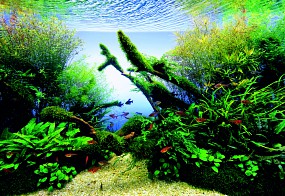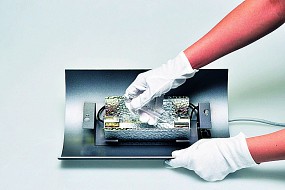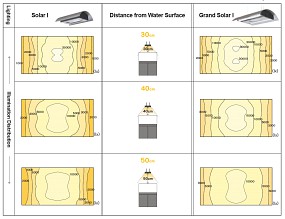Photosynthesis Activity of Aquatic Plants Depends on Light Intensity
Aquatic plants are broadly divided into two types: sun plants that perform active photosynthesis and shade plants that are not very active in photosynthesis. Sun plants such as stem plants and Riccia fluitans undergo strong photosynthesis and grow faster under intense light. On the other hand, shade plants such as ferns and Cryptocoryne can grow healthily even in low light environments and some of them do not grow well if exposed to high intensity light. For Nature Aquariums with both sun and shade plants, the light intensity is adjusted to the level required for sun plants; while shade plants are planted in low-light locations to reduce the amount of light they receive.

Colors of Light for Healthy Growth of Aquatic Plants
Color temperature of artificial light varies by the balance of three primary colors of light (red, green and blue). Some lights have low color temperatures (i.e., red-tinged light) and some have high color temperatures (i.e., blue-tinged light). Red and blue lights are used in photosynthesis of plants. Red light is attenuated rapidly in water while blue light has better penetration in water. Considering this fact, it is assumed that aquatic plants that live underwater mainly use blue light for photosynthesis, NA Lamps having more blue spectrum for the use for Nature Aquariums.
1. Red light is attenuated rapidly as it travels deeper, while blue light is hardly attenuated.
2. In underwater environments, you can see that blue light actually penetrates in water.
Color of Light Changes on Aging Lamps
Fluorescent NA Lamps as well as metal halide NAMH and NAG Lamps are high in blue spectrum to promote the photosynthesis of aquatic plants. When the lamp gets older, the light emitted becomes dimmer and the color of light turns slightly reddish. To maintain the original performance, it is advisable to replace the lamp about once a year.

Appropriate Lighting Period
The light should basically be turned on for 8 to 10 hours a day for Nature Aquariums and it is important to control the regular light period daily. NA Control Timer allows you to control CO2 injection and aeration according to the ON/OFF of the light. In the event of algae bloom, reduce the light period to about 6 hours to inhibit algae growth. Note that it is a prerequisite for Caridina japonica or Otocinclus sp. to be added to the aquarium tank.
1. NA Control Timer allows you to control the regular light period.
2. Aeration is performed when the light is turned off to prevent lack of oxygen.
Aquascape Looks Different under Different Lighting
An Aquascape looks different under metal halide lamps and fluorescent lamps. Aquatic plants and layout materials cast deep shadows under metal halide lamps that emits straight light. In contrast, much less shadows are seen under fluorescent light that emits light in all directions and softly lights up the entire aquarium. Besides the excellent effect of promoting photosynthesis, NAMH with a high color rendering property precisely reproduces the original colors of aquatic plants and on the other hand, NAG emphasizes the green color of the plants.
1. The red color of aquatic plants stands out under the light of NAMH lamp having a high color rendering property.
2. The light produced by NAG emphasizes soothing green colors of aquatic plants.
Adequate light is crucial for a Nature Aquarium in order to grow healthy aquatic plants and beautifully light them up. For the light radiated by an artificial lighting, adequate brightness, color temperature and lighting period as well as color rendering properties are the keys to optimal growth of aquatic plants and the aesthetic of an aquascape. This section explains the light suited to a Nature Aquarium.
Illumination Distribution Varies by Distance between Lighting and Water Surface
Illumination distribution of pendant type ADA Solar I and “Grand Solar I” varies by the distance between the lighting and water surface. When this distance is short, the area directly under the lighting is very bright but there will be a difference in brightness between the center and other parts of the aquarium tank. On the other hand, if such a distance is long, the aquarium is a little dimmer but the before mentioned difference in brightness is much smaller. The height of the lighting should be adjusted according to the type of the layout and species of aquatic plants. The impact of heat when the light is turned on is smaller if the lighting is installed further away from the water surface.

At 30cm:
The center of the aquarium tank is bright. An adequate light intensity is ensured for an aquascape using mainly stem plants and other sun plants. This is the standart installation distance.
At 40cm:
The light is less intense across the aquarium tank including the center area, but it poses a little problem for growing popular aquatic plants. Select this distance when you feel the light is too intense if the lighting is installed 30cm above the water surface.
At 50cm:
This distance allows a wider light radiation range and smaller difference in amount of light. However, the light intensity is much lower for the entire aquarium. Suitable for aquarium using mainly Cryptocoryne and ferns.
The size of all the illumination distribution chart is W90×D45 (cm).
Illumination distribution and underwater brightness vary by the distance between lighting and water surface.
*All the results are based on the measurement made by ADA.
Source and Copyright of the article/photos - Aqua Design Amano - ADA